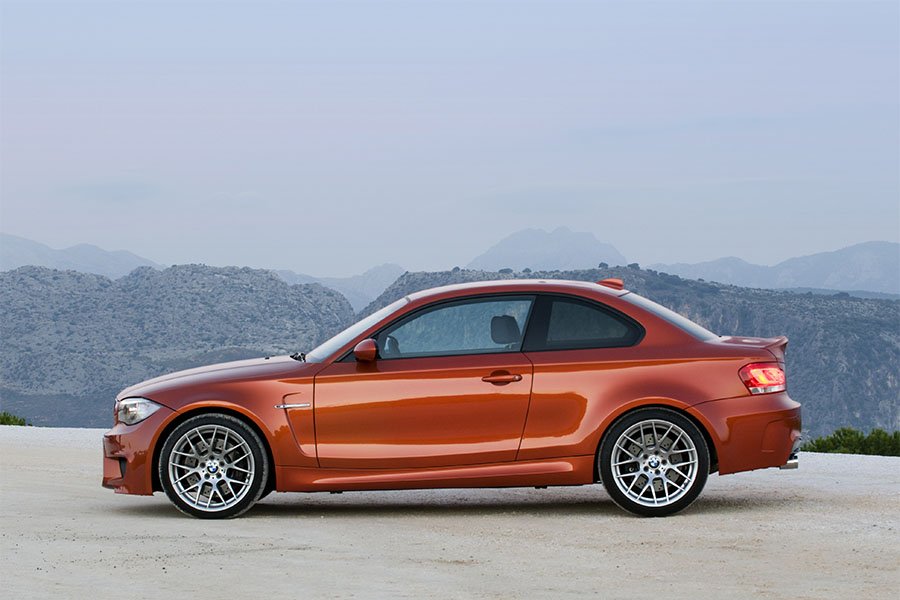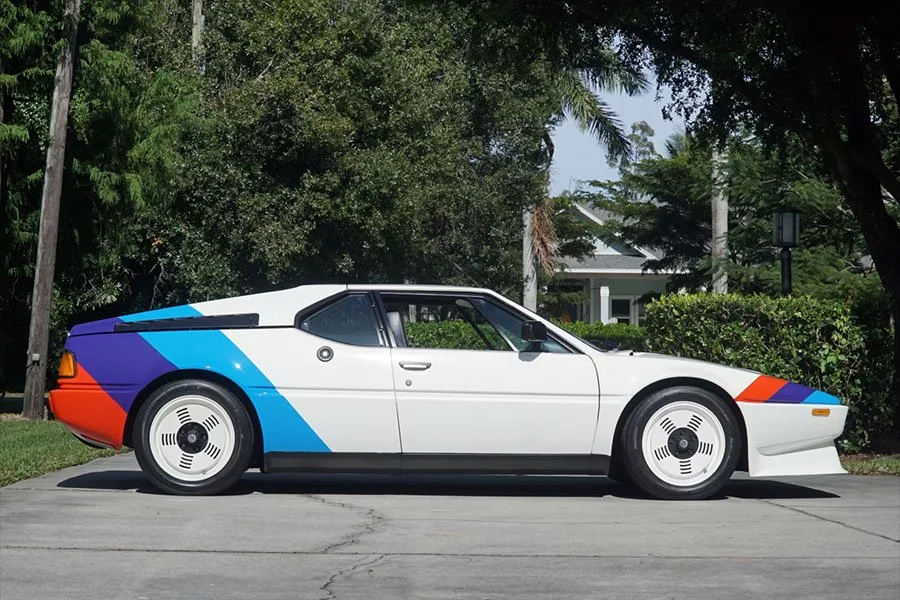Guide: BMW E82 1M Coupe - a Historical & Technical Appraisal
/BACKGROUND
Although BMW had launched the 1-series at the Paris Motor Show back in September 2004, production of a true high performance derivative did not begin for another six-and-a-half years by which time a second generation platform was just around the corner.
BMW conceived the 1-series as a new entry-level compact class offering to rival the likes of Audi’s A3 (introduced back in 1999) and the Mercedes-Benz C-class SportCoupe (launched in 2000).
Initially available as a five-door Hatchback (the E87), this first iteration of the 1-series was followed by a three-door Hatchback (the E81), a two-door Coupe (the E82) and a two-door Convertible (the E88) all of which joined the line up in 2007.
By this point, a full range of engines was available to include inline fours of 1.6 or 2-litres and a three-litre inline six that could be ordered in normally aspirated or twin turbocharged specification.
The BMW Motorsport-tuned E82 1-series M Coupe was announced in July 2010 and then officially unveiled at a press conference in Munch that December. The first customer cars began to roll off the regular 1-series production line in Leipzig during March 2011.
Like most BMW Motorsport products, the 1-series M Coupe followed the well-proven approach of more power, improved handling, increased stopping capability and enhanced looks.
Precisely why it took so long for a Motorsport 1-series to get the green light has never fully been addressed. However, the most likely scenario is that BMW did not want their smallest, most agile but least expensive Motorsport product to embarrass some of the firm’s better known offerings. With that in mind, a limited development budget was allocated to the 1-series M Coupe’s twin turbocharged engine with strict instructions not to change any of the internal components.
As for the new car’s title, although it was effectively an M1 in all but name, BMW refused to countenance use of said tag in recognition of the original E26 M1 produced between 1978 and 1981.
CHASSIS
Each 1-series M Coupe started life as a standard E82 galvanised steel bodyshell.
A 53-litre fuel tank was installed under the rear seat.
As per the rest of the 1-series range, a MacPherson strut front and multi-link rear suspension layout was retained. However, the M Coupe imported much equipment from the contemporary M3 to include that car’s aluminium control arms, aluminium front and rear links, front shock absorbers, front anti-roll bar and front strut brace.
The coil springs, rear shock absorbers and rear anti-roll bar were all M Coupe-specific items.
Instead of the 338mm diameter front and 324mm diameter rear brake discs fitted to the 135i, the M Coupe was equipped with the same cross-drilled and vented 360mm front and 350mm discs as the M3. Single-piston calipers were installed all round.
Other equipment imported from the M3 included the normally optional 19-inch diameter Style 359M Y-spoke alloy wheels offered as part of the Competition Package. These rims were 9-inches wide up front, 10-inches wide at the back and came shod with 245/35 R19 and 265/35 R19 Michelin Pilot Sport PS2 tyres.
The wheels and suspension components sourced from the M3 led to considerably widened track compared to the 135i with an increase of 71mm at the front and 44mm at the rear.
Instead of the regular E82 steering set-up, the M Coupe adopted the speed-sensitive Servotronic power-assisted system from the M3 which had a substantially quicker ratio.
Driver aids included BMW’s Dynamic Stability Control (DSC) which managed the anti-lock brakes (ABS), Anti-Slip Control, (ASC), Dynamic Brake Control (DBC), drive-off assistant, Cornering Brake Control (CBC), an anti-fading function and a brake drying function.
If desired, the DSC system could be switched off entirely or the thresholds at which it intervened adjusted via the M Dynamic Mode (accessed via an ‘M’ button on the steering wheel). Throttle sensitivity could also be adjusted via the M Dynamic Mode technology.
ENGINE / TRANSMISSION
In the engine bay was an uprated version of the twin turbocharged N54 motor used in the 135i from 2007 until 2010. Since September 2010, the 135i had switched to the single turbo N55 engine which meant the M Coupe became the only twin turbo model in the 1-series range.
A Type N54B3OTO straight six was internally identical to the N54 motors that came before, but could be identified on account of its ‘Powered by BMW M’ cam cover. Meanwhile, thanks to re-mapped engine management software, an increase of the turbo boost pressure from 0.6 to 0.8 bar and a new free-flow four-outlet exhaust system, peak output rose to 335bhp at 5900rpm and 369lb-ft at 1500-4500rpm with an extra 37lb-ft available at full throttle by means of an overboost function.
For comparison, the old twin turbo 135i had produced 302bhp at 5800rpm and 295lb-ft at 1300-5000rpm.
Like all N54 motors, the M Coupe power unit was an all-alloy straight six with dual overhead camshafts and four valves per cylinder. It featured two relatively small turbos, petrol direct injection, a 10..2:1 compression ratio and wet-sump lubrication.
Uniquely for a modern BMW Motorsport product, the 1-series M Coupe was available exclusively with a Getrag Type K six-speed manual gearbox.
Transmission was through a single-plate clutch and BMW’s M Differential Lock which was effectively an updated limited-slip diff. It pressurised a viscous silicon fluid when there was a difference in rotational speed between the rear wheels and then activated a multi-disc clutch that directed more power to the wheel with the greatest traction.
BODYWORK
Although the M Coupe’s engine modifications were relatively minor compared to some BMW Motorsport power units, its exterior detailing differed substantially from more mainstream 1-series variants to the extent that only the roof, doors and hood were sourced from the regular E82 Coupe.
All four fenders were dramatically flared to cover the big 19-inch wheels while also down each flank were sporty new side skirts plus M3-style rear view mirrors and M-branded LED indicators.
To complement the more macho wide-arched look, BMW Motorsport created aggressive new bumper assemblies designed with improved airflow and additional downforce in mind.
The front bumper featured larger intakes, re-profiled pylons, elaborate canard-style spoilers and innovative outer section air curtains designed to reduce high speed turbulence around the front wheel zone.
The rear bumper was also suitably re-styled. Vertical air vents reduced air pressure and heat from the rear arches and a more prominent diffuser was added that incorporated four instead of two exhaust tips.
A discrete lip spoiler lip on the trunk lid yielded additional rear axle downforce at high speeds.
High-gloss Shadowline exterior trim was standard along with Xenon headlights.
To illustrate just how big modern cars had become, even though the 1-series was brought to market as BMW’s new compact class offering, the M Coupe was still bigger in every department than the E30 M3 produced between 1986 and 1991 (34mm longer, 123mm wider, 50mm taller and with a 38mm longer wheelbase).
INTERIOR
As per the exterior, BMW Motorsport pushed the boat out with the M Coupe’s interior which was configured to a very high specification.
The instrumentation hood, dash insert, door panel inserts, door grab handles, gear gaiter and handbrake gaiter were all upholstered in in dark grey alcantara with contrast orange stitching.
Black Boston leather with contrast orange stitching was used for the seats.
A leather-trimmed Motorsport steering wheel came with unique blue and orange stitching.
Other Motorsport equipment included a short-shift gear knob and 8000rpm rev counter which, like the 300kmh / 200mph speedometer, featured a grey inlay with white typeface.
On top of all that, this flagship of the 1-series range automatically received the M Sport package available on the rest of the E82 range which included sport seats, an aluminium footrest shroud, Motorsport-branded sill plaques and anthracite headliner.
Although not a de facto limited production model, some markets like the UK and France received a pre-set allocation of cars (450 and 100 respectively) which were equipped with commemorative cockpit plaques.
OPTIONS
The only colour combination for the 1-series M Coupe offered as standard was Alpine White paint with Black Boston leather upholstery and Orange contrast stitching.
At additional cost, customers could choose from one of two metallic paint shades: Black Sapphire and Valencia Orange.
Just a tiny handful of cars were produced in other colours via BMW Individual.
The list of optional extras included electric seats with driver memory function, electric front lumbar support, heated front seats, electric folding mirrors, privacy side glass, a graduated tint windscreen, adaptive headlights, high-beam assist, keyless entry / start, a through-loading rear seat with modular ski bag and voice control.
BMW also offered a Harman/Kardon audio system with optional Harman/Kardon loudspeaker system, a BMW Professional radio with single CD player and MP3 playback capability, a BMW Business loudspeaker system, a DAB digital radio, a six-disc CD changer, a USB audio interface, a satellite navigation system, a BMW Professional Multimedia navigation system, Bluetooth telephone preparation, Bluetooth telephone preparation with telematics, Bluetooth hands-free facility and a telephone USB audio interface.
No-cost options included Chromeline window trim, model designation delete and smoker pack delete.
WEIGHT / PERFORMANCE
As a consequence of its much higher basic specification, the 1-series M Coupe weighed in at 10kg more than the old 135i (1570kg as opposed to 1560kg).
However, the BMW Motorsport product was much faster in every respect and had a 0-62mph time of just 4.9 seconds (four tenths down from the 135i).
Both cars were electronically limited to a top speed of 155mph.
END OF PRODUCTION
BMW produced the 1-series M Coupe for just 16 months between March 2011 and June 2012.
6342 examples were built during this period split as follows:
LHD Euro specification (03/2011 to 06/2012) 4155 built
RHD Euro specification (03/2011 to 06/2012) 1204 built
LHD North American specification (03/2011 to 12/2011) 983 built
Text copyright: Supercar Nostalgia
Photo copyright: BMW - https://www.bmw.com








































